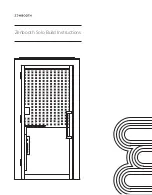
AMPLITUDE ACCURACY
Due to the variations in V
F
as a function of operating conditions, the amplitude
settings
should not be relied upon for any degree of accuracy
. Instead the voltage at
the OUT terminal on the test jig should be monitored with a calibrated oscilloscope.
R
B
can be measured directly on the test jig (with the test jig disconnected) to determine
calibrated relationships, if desired. R
C
is provided by the user, and can be calibrated as
required.
INCORRECT ORIENTATION
The instrument and the DUT will not be damaged if the diode is installed with the
incorrect orientation (i.e., with the anode and cathode reversed). However, incorrect
waveforms will be generated,
CABLE LENGTHS
The cable lengths are not critical. They may be increased or decreased as desired.
The cables connecting the OUT and MON signals to the oscilloscope should have
identical lengths, to avoid introducing timing skews.
ACCESSIBLE VOLTAGES
The AVR-EBF6-B mainframe provides pulsed voltages of up to 100V to the test jig. For
this reason, the output is automatically disabled when the test jig lid is open. The lid
must be closed to obtain measurements.
Shielded cabling should be used for all connections to the "IN" and "OUT"
terminals on the test jig, and the "OUT" connector on the AVR-EBF6-B mainframe.
When used properly (with R
C
= 50 Ohms), the maximum voltage on the OUT
terminal will be < 1V, approximately. However, if R
C
is not connected and the DUT is
not installed, the maximum voltage will at the OUT terminal may be as high as 100V.
You may need to consider whether this scenario would damage your oscilloscope, and
take appropriate precautions.
6
Summary of Contents for AVX-FILT Series
Page 7: ...PERFORMANCE CHECK SHEET 7...

























